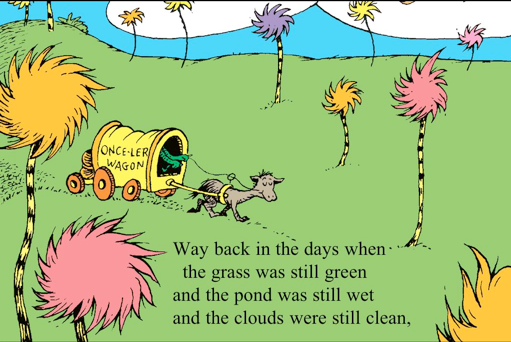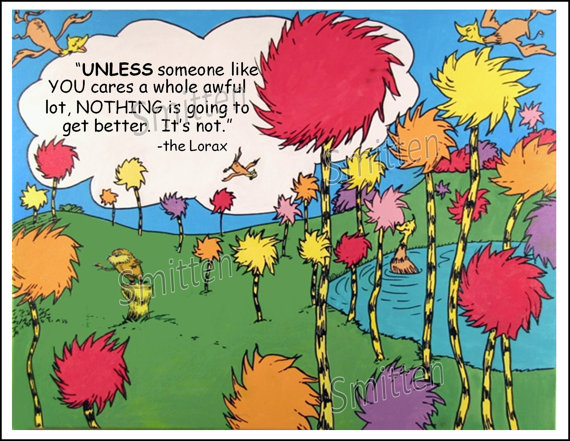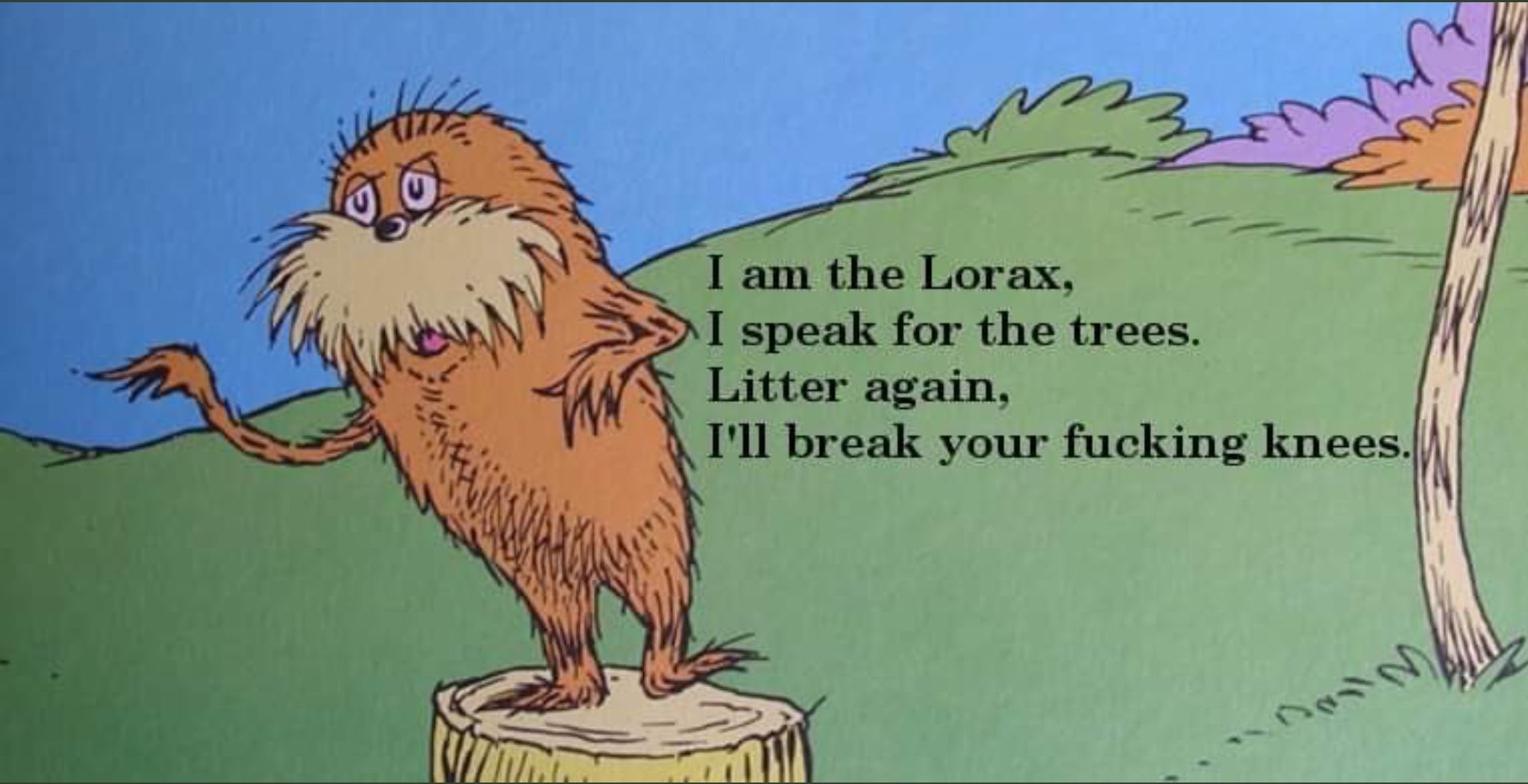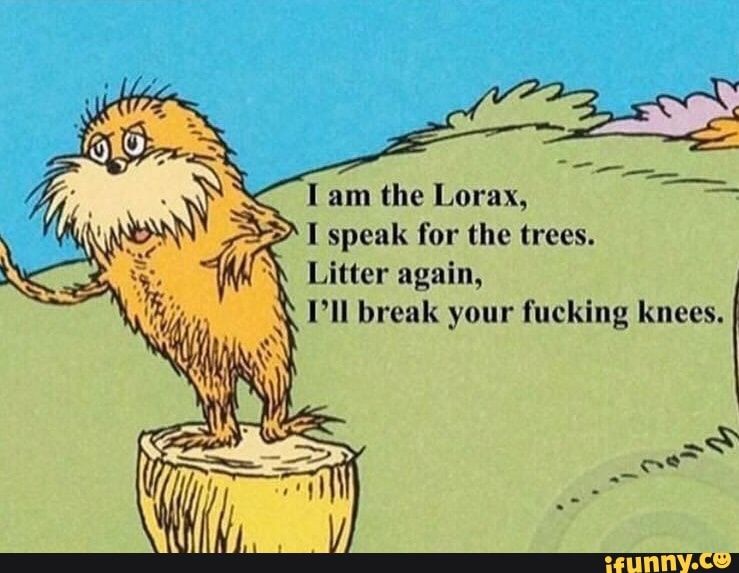Are you familiar with “The Lorax” by Dr. Seuss? This classic children’s book is not just an entertaining story, it also carries a powerful environmental message. In this blog post, we will explore the deeper meaning of “The Lorax” and its relevance to sustainability. We’ll delve into the environmental questions raised in the book, the problems caused by the Once-ler, and the impact of the thneed on the environment. We’ll also examine the iconic quote “A tree falls the way it leans. Be careful which way you lean,” and the significance of the Lorax’s warnings. So, sit back, relax, and let’s explore the world of “The Lorax.”

Exploring the Environmental Message of the Lorax: Understanding the Famous Quote.
The Lorax, a beloved children’s book written by Dr. Seuss, is known for its powerful and thought-provoking environmental message. One of the most famous quotes from the book is “A tree falls the way it leans. Be careful which way you lean.” This quote serves as a reminder of the impact our actions have on the environment and the importance of being mindful of the choices we make.
The quote can be interpreted in several ways, but its underlying message is clear: our actions have consequences, and we must be mindful of the direction in which we are headed. It encourages readers to be cautious about the decisions they make, as they can have a significant impact on the world around us.
This quote also serves as a warning against greed and short-term thinking. The Once-ler’s actions in the book reflect this, as he prioritizes his own profit over the health of the environment. The quote encourages readers to think beyond their immediate interests and consider the long-term effects of their actions.
Overall, the “tree falls the way it leans” quote from The Lorax is a powerful and timeless reminder of the importance of environmental stewardship and the impact our choices have on the world around us.
>> Must read What is the Grinch answering machine phone number?
Exploring Environmental Themes in The Lorax: Key Questions to Consider.
The Lorax is a story that inspires readers to think about the environment and the impact of human actions on nature. The book raises several environmental questions that can help us reflect on our own relationship with the planet. One of these questions is how the Once-ler could have used the Truffula Tree without cutting it down. This is an important question to ask because it challenges us to think about sustainable practices that can help us use natural resources without depleting them.
There are several ways that we use trees without destroying them. For instance, we can use fallen leaves and branches as compost for our gardens. We can also use trees to provide shade, which can help reduce energy consumption in our homes. Additionally, we can plant trees and other plants to restore ecosystems that have been damaged by human activities.
Another question that the Lorax raises is whether the Lorax liked his environment before the Once-ler arrived. This question invites us to consider the role of human actions in shaping the natural world. It also highlights the importance of preserving natural habitats for the benefit of all living beings.
Reflecting on our own environment, we can ask ourselves what we would be sad to see changed or lost. This question encourages us to think about the value of nature and the impact that our actions can have on it. It can help us appreciate the beauty and diversity of the natural world and inspire us to take action to protect it.
Trending now – What is Shrek slang for?
The Lorax: Uncovering the Hidden Message.
The Lorax by Dr. Seuss, is more than just a children’s book. It is a powerful environmental warning that highlights the disastrous effects of unchecked industrialization. The book is a cautionary tale about the consequences of exploiting natural resources for commercial gain. The story is set in a beautiful forest of Truffula trees, which are cut down by the Once-ler to make thneeds, a versatile garment that becomes a craze among the masses. As the Once-ler’s business grows, he ignores the environmental damage he is causing, leading to the depletion of the Truffula trees and the destruction of the forest.
The deeper meaning of the Lorax is that we must take responsibility for our actions and the impact they have on the environment. The book shows that the pursuit of profit at the expense of nature is unsustainable and ultimately leads to disaster. It highlights the importance of protecting the environment and preserving natural resources for future generations.
Despite the bleak picture the book paints of environmental destruction, it ends on a hopeful note. The Once-ler finally realizes the error of his ways and gives a young boy the last remaining Truffula seed. This symbolizes the possibility of regenerating the forest and starting afresh. The book encourages readers to take action to protect the environment, and to advocate for sustainable practices that do not harm the planet.
The Lorax has become a classic in children’s literature and is widely used as a teaching tool to educate young minds about environmentalism. The book’s popularity has only grown over the years, selling more than 200 million copies worldwide. Its message is still as relevant today as it was when it was first published in 1971. It serves as a reminder that we must all do our part to protect the planet and ensure a sustainable future for all living things.

The Impact of the Once-ler on the Environment: A Closer Look at the Consequences of his Actions
The Once-ler, a character from Dr. Seuss’s “The Lorax,” is the cause of significant environmental problems in the story. His insatiable desire for wealth and success led him to disregard the impact of his actions on the environment. He began cutting down the Truffula trees, which were the source of life for the environment, and continued to do so despite the warnings of the Lorax. The Once-ler’s actions not only destroyed the trees but also the habitat of the animals and the homes of the Whos.
The Once-ler’s disregard for the environment led to the pollution of the air, water, and soil. As he continued to chop down the trees, he created factories that spewed smoke into the air and released toxic waste into the water. The pollution caused by his factories led to the death of the fish and other animals, leaving the once-beautiful environment desolate and barren.
The Once-ler’s actions also affected the lives of the animals living in the area. He destroyed the homes of the animals, and the lack of trees left them with no shelter or food. The birds, who once sang in the trees, left the area due to the destruction of their habitat.
In summary, the Once-ler caused significant environmental problems by cutting down the Truffula trees, polluting the air and water, and destroying the homes of animals. His actions are a reminder of the importance of environmental conservation and the impact that our actions can have on the world around us.
The Environmental Impact of the Thneed.

The production of thneeds had a severe impact on the physical environment. The Once-ler’s factory emitted toxic smoke and polluted water, leading to the depletion of natural resources and the destruction of the ecosystem. The pollution caused a hole in the ozone layer, which allowed harmful UV rays to reach the surface of the earth, endangering living beings. The air became thick with smog, making it difficult to breathe, and the water became dirty and polluted, making it unusable for both humans and animals.
One of the most striking examples of the impact of thneed production on the environment is the disappearance of the humming fish. These fish, which were once abundant in the area, left because their water had become so polluted that they could no longer survive. This is a clear example of how pollution affects not only the immediate area but also the wider ecosystem.
The production of thneeds also led to the destruction of trees and other vegetation, which had a ripple effect on the entire ecosystem. Without vegetation to absorb carbon dioxide, the levels of this greenhouse gas in the atmosphere increased, contributing to climate change.
In conclusion, the production of thneeds had a devastating impact on the physical environment, leading to pollution, the depletion of natural resources, and the destruction of the ecosystem. The disappearance of the humming fish is just one example of the many negative consequences of the Once-ler’s actions. It highlights the importance of considering the long-term impact of our actions on the environment and the need to prioritize sustainability in all our endeavors.
The Lorax: A Tale of Environmental Responsibility and Preservation.
“The Lorax” by Dr. Seuss is a timeless classic that has been teaching children about the importance of sustainability for over 50 years. The story is about the Once-ler, an entrepreneur who discovers a new product called the thneed, which is made from the Truffula trees. The Once-ler’s desire for profit leads him to cut down all the Truffula trees, causing the environment to suffer. The Lorax, a creature who speaks for the trees, warns the Once-ler about the consequences of his actions, but the Once-ler ignores his warnings.
The Lorax is a story about sustainability because it highlights the importance of preserving natural resources for future generations. The Once-ler’s greed and lack of concern for the environment led to the destruction of the Truffula trees and the ecosystem they supported. The story also serves as a cautionary tale about the dangers of unsustainable growth and overconsumption.
The Lorax encourages readers to be mindful of their impact on the environment and to take action to protect it. It promotes sustainable practices such as reducing waste, conserving resources, and protecting endangered species. The story also emphasizes the importance of individual responsibility in creating a sustainable future.
In conclusion, “The Lorax” is a story that teaches children and adults alike about the importance of sustainability. It demonstrates the consequences of unsustainable growth and the impact it has on the environment. The Lorax encourages readers to be mindful of their impact on the environment and to take action to protect it, promoting a sustainable future for all.
The Final Words of the Lorax: What was the Last Line?
The final line of the Lorax, “As long as hope maintains a thread of green,” encapsulates the overall message of the story. Throughout the book, the Once-ler’s greed and disregard for nature lead to the destruction of the Truffula trees and the vibrant ecosystem that once thrived in the area. The Lorax, a guardian of the forest, tries to reason with the Once-ler and prevent the destruction, but ultimately fails.
However, the final line suggests that there is still hope for the environment, as long as people are willing to recognize the importance of nature and take action to protect it. The phrase “a thread of green” implies that even the smallest efforts to preserve the natural world can make a difference.
It is interesting to note that like the Pulitzer Prize-winning novel, “The Grapes of Wrath,” hope is not present until the very end of the Lorax. This emphasizes the idea that change is possible, but it requires perseverance and a willingness to take action. The last line of the Lorax leaves the reader with a sense of optimism, encouraging them to take responsibility for the environment and work towards a sustainable future.
The Final Words of The Lorax: Understanding its Message for Today’s World
The last statement in the Lorax has a deeper message that can be interpreted in different ways. The Once-ler’s reflection on his actions leads him to leave readers with a powerful quote that highlights the importance of taking action and being responsible for our impact on the environment. He states that “Unless someone like you cares a whole awful lot, nothing is going to get better. It’s not.” This quote emphasizes the critical role that individuals play in environmental conservation. The Once-ler’s admission of guilt and his understanding that his actions have caused irreversible damage to the environment makes this quote all the more potent.
This quote resonates because it is a reminder that we all have a responsibility to take action to protect the environment. It is not enough to sit idly by and watch as environmental destruction occurs. Each individual has the power to make a difference and to be a part of the solution. The Lorax’s message is a call to action for all of us to take responsibility for our impact on the environment and to take steps to protect it for future generations.
In conclusion, the saying at the end of the Lorax is a powerful and thought-provoking message that encourages individuals to take action and to care about the environment. The Once-ler’s reflection on his actions and the damage he has caused is an important reminder that we all have a role to play in environmental conservation. It is up to us to care a whole awful lot and to take action to make a positive impact on the environment.
Is there profanity in the book/movie “The Lorax”?
The Lorax, a popular children’s book by Dr. Seuss, has been adapted into a movie that has become a family favorite. Parents often wonder if the movie contains any objectionable language that may not be suitable for their children. The good news is that there are no swear words in the movie. While there is one instance of an insult directed towards a character, it is hardly even a swear word. Therefore, parents can rest assured that their children can watch this movie without being exposed to any inappropriate language. The Lorax is definitely safe for younger children in that respect. It is a great movie to watch as a family, especially for parents who are looking for a wholesome and educational movie that teaches the importance of environmental conservation.
The Lorax’s Initial Cautionary Message.
In the popular children’s book “The Lorax,” the titular character, a small, mustachioed creature, warns the Once-ler about the destruction of the environment. However, before the Once-ler starts chopping down the truffula trees, the Lorax gives him a warning. The first warning the Lorax gives the Once-ler is to “speak for the trees.” This means that the Once-ler should be a voice for the trees and the environment, instead of just focusing on his own profits. The Lorax believes that if the Once-ler can speak up and make others aware of the damage being done, they will be more likely to take action and preserve the environment. Unfortunately, the Once-ler ignores the Lorax’s warning and continues to chop down trees, causing irreversible damage to the environment. The warning to “speak for the trees” is a powerful message about the importance of environmental activism and the need for individuals to take responsibility for the impact they have on the world around them.
The Lorax is not just a children’s book, it’s a powerful message about the environment and sustainability that we all need to pay attention to. From the environmental questions raised in the story to the warning of the Lorax, the deeper meaning of this story is clear – we need to take care of our planet before it’s too late. The Once-ler’s actions and the impact of the thneed on the environment serve as a reminder of the consequences of our actions. The last line of the book, “Unless someone like you cares a whole awful lot, nothing is going to get better. It’s not,” is a call to action for every reader to take responsibility for the world we live in. So let us all remember the Lorax’s warning – “A tree falls the way it leans. Be careful which way you lean.” and do our part to create a more sustainable and healthy planet.



